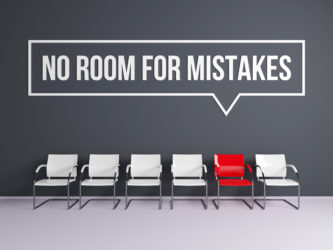5 Common Hiring Mistakes (and How to Avoid Them)
by
Save time and money by reducing hiring mistakes.
Finding the right employee to fill a position can feel like trying to find a needle in a haystack. While you know the required skills and what a dream candidate looks like, it’s often hard to find that desired person in a stack of resumes. Anyone who’s hired a bad candidate knows the consequences that can have on an organization.
According to the Department of Labor, the average cost of a bad hiring decision is at least 30 percent of the individual’s first-year expected earnings, though some may argue there are also non-monetary costs such as time spent managing poor performance and impact on team morale. In order to save money and the headache of a bad hire, below is a list of the top hiring mistakes employers make and how to avoid them.
- Not realizing the job market is about supply and demand
Like the housing market, the job market is also subject to supply and demand. When there are fewer jobs and more candidates the market favors employers because people looking for jobs are abundant. If there are more jobs and fewer candidates, job seekers will be selective about the offers they take because they know there will be more available.
In the past employers’ market hiring managers had plentiful options. However, that has changed and currently, we are in a candidate’s market. This means those seeking work have multiple opportunities and are scrutinizing job opportunities more than ever. While it’s still possible to find great candidates, it may take longer or you may need to cast a wider recruitment net and be open to a non-traditional candidate who would still make a great employee at your company.
- Trying to find the “perfect” candidate on paper
One big mistake companies make is trying to find the “perfect” candidate on paper, which can lead to missing out on great candidates whose resume is not an exact fit but have other soft skills that would make them an excellent employee like outstanding communication skills and working well with a team.
Ross Coley, Vice President and Executive Recruiter, of Coley Executive Search Firm, advises not getting too caught up in finding the perfect resume, “Often companies will get tunnel vision on specific things and end up searching too long. The hiring process is like a dartboard, the bullseye candidate is very hard to find, so you may need to move to the ring outside and get most of what you want and make up the rest with intangible skills.” After all, if a candidate’s personality clashes with the company culture, no matter how good they look on paper, it’s not going to work in the long run.
- Not moving fast enough
In a job applicant’s market, qualified individuals are getting scooped up quickly. Once you find the candidate you want to hire, you need to move fast. Most interviewees are speaking with several companies and getting multiple offers so moving the interview and offer process quickly is key to getting the best candidates.
If the interview process is too slow, candidates may get hired by other companies or lose interest altogether. If your interview process is lengthy, you may want to consider options for reducing the time it takes to get through the process such as having multiple people in an interview or using a recruiting firm. It also helps to give candidates a general timeline of the next steps and follow-up such as when the next interview will be or when they can expect to hear back, so they are not left wondering where they are in the process.
- Not selling the company
Job seekers are much savvier now about the companies they work for and the positions they take. Interviewing is a two-way street, not only are companies interviewing the candidate but candidates are interviewing the company as well. When job opportunities are seemingly everywhere, companies need to sell themselves in the interview. Get employees excited about what makes working there so great and the perks outside the salary, like the friendly company culture or great work-life balance.
- Not open to working from home and remote work
If there’s one thing the pandemic changed it’s the ability to work from home or just about anywhere—and many people do not want to give that up. If companies are not open to working from home or at least partial remote work, it limits the available talent pool.
Also, from a potential employee’s perspective if the job does not absolutely require being in person, making it mandatory to come into the office may seem like the company does not trust their employees and wants to keep a watchful eye on them. It can also signal the employer does not measure work productivity efficiently, or values time spent in the office over actual work getting done, all of which could be a turn-off to a potential high-performing candidate.
If your company has struggled with any of these mistakes before, give us a call 336-218-6637. We want to help you get it right the first time.
